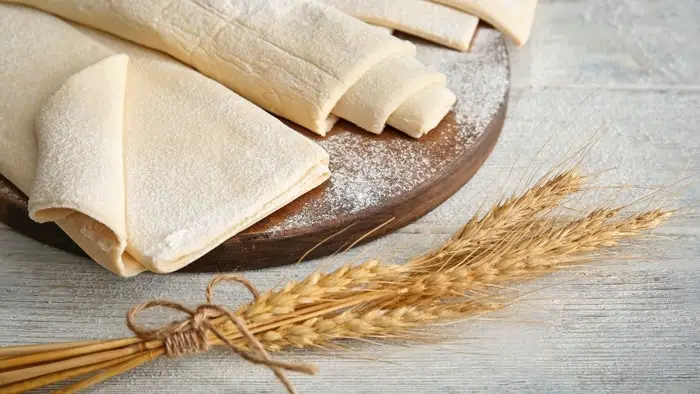Last Updated on September 3, 2021
Today we’re going to be looking at phyllo (often referred to as filo) dough. What is phyllo? What is it made from? And does phyllo dough have gluten?
What Is It?
There are many different types of pastry. The two most common being puff pastry and filo (phyllo) pastry. Puff pastry is much more fluffy and contains large amounts of butter whereas filo pastry is quite often fat-free and requires very few ingredients. Compared to other pastries, it is a far healthier option. Phyllo is an unleavened dough. This means that they don’t rise in the oven and will stay thin and flaky.
The sheets of pastry made from the dough when layered and cooked result in a crispy, melt-in-the-mouth texture. When baked, the layers are extremely delicate and crack easily. Phyllo dough works well in dishes such as baklava and savory starters. It’s very popular in Greek and Middle Eastern cuisine.
What Is Phyllo Dough Made Out Of?
Phyllo dough can be made out of a variety of ingredients but the main ingredients used are flour, water, oil, and/or vinegar. Some recipes also include egg yolk. I find the most delicious as a dessert but they can be filled with absolutely anything. It sounds relatively easy to make, but it’s a lot trickier than it may first seem!
Does Phyllo Dough Contain Gluten?
When you pull up a recipe from the internet, the majority of the results you’ll find will not be suitable for celiacs or gluten-intolerant individuals. That is because the basis of the recipe is flour. Although there are many types of flour, the most widely used is wheat flour. So the answer is yes – a traditional phyllo dough recipe does contain gluten. But that definitely does not mean that the recipe can’t be changed to suit us!

Learn more about: Substitution For Graham Cracker Crumbs
Can Phyllo Dough be Gluten-Free?
Like most foods, it, of course, can be adapted to suit a gluten-free lifestyle. Whereby you would usually add wheat flour, there’s a range of alternatives you can use to make it suitable. Rice flour, tapioca flour, soy flour, and gluten-free all-purpose flour blend are great alternatives for making tasty phyllo dough.
When cooked gluten-free pastry can taste quite cardboard-like and lack flavor. This post will ensure you will always have flaky, yummy pastry at hand. Whether that be from your local grocery store or homemade. There are choices to suit everyone’s lifestyle.
Shop Bought Gluten Free Filo
Many grocery stores will have ready-made gluten-free filo pastry. It will already be rolled and prepared for you to make your gluten-free treats. If you want to skip the making process altogether, there will usually be some gluten-free filo goodies already available to buy. Fairly recently, in November 2019, Athens Foods introduced their Gluten-Free Phyllo Bites which come in a range of delicious flavors – spinach and cheese, steak fiesta, and buffalo style chicken.
Making Phyllo Dough Yourself?
Filo is difficult to make at the best of times, so making gluten-free filo dough is no easy feat! Mastering the art of filo takes time and skill. There’s a lot of stretching, a lot of rolling – and usually a very large table to work on. Baking by hand needs continual flouring to stop the extremely thin layers sticking together and is usually made with a rolling pin.
And I’m not sure if it’s just me but does anyone else find gluten-free pastry almost impossible to get crispy?! Whilst baking in the past, I can leave a pastry in for hours and it just remains anemic and not very aesthetically pleasing. In this day and age, we want our food to look Instagram-worthy, right?
Well, look no further! I’ve found a recipe with delicate, flaky pastry that actually turns golden brown and looks mouth-wateringly delicious. This recipe is for Gluten-Free Phyllo Dough and also shows you how to make spanakopita – a Greek savory pie; made with filo pastry, of course.
Better Batter Gluten-Free flour is a great one to use when making your own phyllo dough and is highly recommended in the gluten-free community. Better Batter has a great range of tasty GF mixes and a range of recipes available on their website.
Tips for Making Gluten-Free Filo Dough
- Don’t leave it uncovered for more than a minute at a time as it dries out extremely easily
- Make sure you’re using a large enough workspace
- Always work with dry hands, as dampness can make the dough gummy
- Always use a sharp knife
- Prepare the filling before you start working on the pastry – it can go wrong quickly!
- Try not to brush the pastry too hard as it has a tendency to break
- It’s normal for pieces to become brittle and break off – don’t worry, it can be reused at a later stage
Of course, these tips are also applicable when making the traditional style filo dough – but we’re just focusing on the gluten-free dough today!
The Future for Filo
Gluten-free phyllo seems to be an overlooked part of the pastry sector. There seems to be an abundance of gluten-free puff pastry and nowhere near as many readily available filo options. Do they not realize how grateful we would be for this gluten-free goodness?! The world is slowly becoming easier for us gluten-intolerant folk but we’re definitely not quite where we’d like to be yet.
Do you have any recommendations for gluten-free filo dough? The community certainly needs some more recipes to enjoy! And the more it’s discussed, the better chance we have of more options becoming available in the future. Do you buy a ready-made pastry, or prefer to start from scratch? Or are you like me and buy your desserts already made? Hey, not all of us can be master bakers!

Hi, my name’s Zoë. I’m 28 years old and live in London, UK. I work full time as a freelance writer and critic for West End theatre. Writing has been a passion of mine for as long as I can remember. I spend most of my free time at the theatre, or at conventions. I’m married to the love of my life, and live in a small apartment with my fur baby, Lillie. I run two of my own blogs: No Safer Place and Stage to Page: both of which have won awards. I also have a YouTube channel where I talk about all things stagey.
